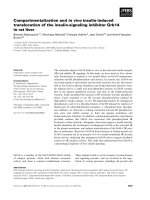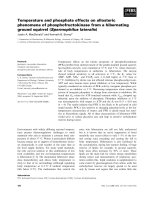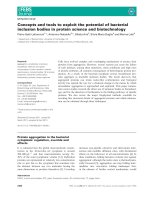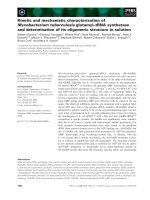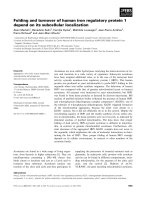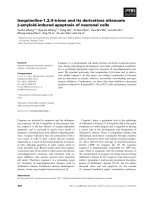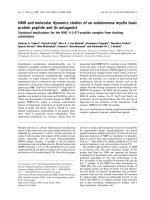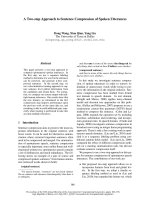Báo cáo khoa học: Isoquinoline-1,3,4-trione and its derivatives attenuate b-amyloid-induced apoptosis of neuronal cells pdf
Bạn đang xem bản rút gọn của tài liệu. Xem và tải ngay bản đầy đủ của tài liệu tại đây (533.1 KB, 11 trang )
Isoquinoline-1,3,4-trione and its derivatives attenuate
b-amyloid-induced apoptosis of neuronal cells
Ya-Hui Zhang1,*, Hua-Jie Zhang1,*, Fang Wu1, Yi-Hua Chen1, Xue-Qin Ma2, Jun-Qin Du1,
Zhong-Liang Zhou2, Jing-Ya Li1, Fa-Jun Nan1 and Jia Li1
1 National Center for Drug Screening, Shanghai Institute of Materia Medica, Shanghai Institutes for Biological Sciences, Chinese Academy
of Sciences, Shanghai, China
2 East China Normal University, Academy of Life Science, Shanghai, China
Keywords
attenuate apoptosis; b-amyloid; caspase-3
inhibitor; irreversible; neuronal cell
Correspondence
J. Li or F.-J. Nan, 189 Guo Shou Jing Road,
Shanghai 201203, China
Fax: +86 21 50801552
Tel: +86 21 50801313
E-mail: or
Caspase-3 is a programmed cell death protease involved in neuronal apoptosis during physiological development and under pathological conditions.
It is a promising therapeutic target for treatment of neurodegenerative diseases. We reported previously that isoquinoline-1,3,4-trione and its derivatives inhibit caspase-3. In this report, we validate isoquinoline-1,3,4-trione
and its derivatives as potent, selective, irreversible, slow-binding and pancaspase inhibitors. Furthermore, we show that these inhibitors attenuated
apoptosis induced by b-amyloid(25–35) in PC12 cells and primary neuronal
cells.
*These authors contributed equally to this
work.
(Received 14 April 2006, revised 27 August
2006, accepted 30 August 2006)
doi:10.1111/j.1742-4658.2006.05483.x
Caspases are involved in apoptosis and the inflammatory response. Of the 14 members of this protease family, caspase-3 is the key effector of caspase-dependent
apoptosis, and is activated in nearly every model of
apoptosis, including those with different signaling pathways. Caspase-3-deficient mice die prematurely with a
vast excess of cells in their central nervous systems,
apparently as a result of decreased apoptosis of neuronal cells, although apoptosis in other organs seems to
occur normally [1,2]. Recent studies show that caspase3 activation may be involved in other acute and chronic
neurodegenerative processes, and treatment with caspase inhibitors may protect neurons from apoptotic
cell death. Therefore, caspase-3 is a promising target
for treatment of neurodegenerative diseases, such as
Alzheimer’s disease, Parkinson’s disease, Huntington’s
disease, stroke, amyotrophic lateral sclerosis [3–6].
Caspase-3 plays a prominent role in the pathology
of Alzheimer’s disease [7]. b-Amyloid (Ab) is the major
component of senile plaques and is regarded as playing
a causal role in the development and progression of
Alzheimer’s disease. There is compelling evidence that
Ab-induced cytotoxicity is mediated through oxidative
and ⁄ or nitrosative stress and induces neuronal apoptosis. Ab is derived from cleavage of amyloid precursor
protein (APP) by caspases [8]. Of the caspases,
caspase-3 is predominantly responsible for APP cleavage, which is consistent with the marked elevation in
the concentration of caspase-3 in dying neurons during
Alzheimer’s disease [9–11]. Caspase-3 also cleaves presenilin-1, presenilin-2, and tau, key proteins in the pathogenesis of Alzheimer’s disease [12,13]. Ab can induce
neuronal stress and cell apoptosis via the cascade
of caspase-3-mediated signal transduction pathways.
Abbreviations
Ab, b-amyloid; APP, amyloid precursor protein; MTT, 3-(4,5-dimethylthiazol-2-yl)-2,5-diphenyl-tetrazolium bromide.
4842
FEBS Journal 273 (2006) 4842–4852 ª 2006 The Authors Journal compilation ª 2006 FEBS
Y.-H. Zhang et al.
Caspase inhibitors attenuate Ab-induced apoptosis
Several studies have suggested that inhibition of
caspase-3 activity can block induction of apoptosis by
Ab in primary neuronal cells and PC12 cells [14]. The
neurotoxicity of Ab seems to depend on its ability to
aggregate, and the active portion of the Ab molecule
appears to be the amino acids 25–35 fragment [15,16].
Most caspase-3 inhibitors are peptidyl inhibitors.
Benzyloxycarbonyl-Val-Ala-Asp-fluoromethylketone
(Z-DEVD-fmk) and N-acetyl-Asp-Glu-Val-Asp-aldehyde (Ac-DEVD-CHO) (peptides that compete for specific recognition sites on the substrate of caspase-3)
block cell death in animal models of stroke, myocardial ischemia-reperfusion injury, liver disease, sepsis,
and traumatic brain injury [3,17–20]. Although some
peptidyl caspase inhibitors are effective, the pharmacokinetics of these inhibitors prevent their use in clinical
environments. Small molecules that inhibit caspase-3
activity would be valuable for treatment of diseases
involving excessive cell death.
Few small-molecule inhibitors against caspase-3 have
been reported [21–24]. Isatin sulfonamide and its analogues are potent and selective inhibitors of apoptosis
of chondrocytes and mouse bone marrow neutrophils
in cell-based models of osteoarthritis [25]. M-791 reduces mortality by 80% in murine and rat sepsis models
by preventing apoptosis of B and T cells [23]. Recently,
two caspase inhibitors were subjected to clinical trials.
VX-740 (pralnacasan, Vertex Pharmaceuticals), a
potent inhibitor specific for caspase 1, is undergoing
phase II clinical trials for osteoarthritis. However, it
was recently withdrawn for treatment of rheumatoid
arthritis because of evidence of abnormal liver toxicity
in a long term phase II animal study [26]. The irreversible pan-caspase inhibitor, IDN-6556 (IDUN Pharmaceuticals) has successfully completed phase I studies.
IDN-6556 prevents cold- and ischemia-induced apoptosis in donor livers and reduces sinusoidal endothelial
CMe O
O
Results
Preparation of active caspases
His6-labeled caspase 2, 3, 6, 7, 8, and 9 were purified
from supernatants of cell lysates using HiTrap affinity
chromatography. The caspase solutions were 90%
pure, and 15% SDS ⁄ PAGE revealed they contained
20 kDa and 10 kDa subunits, which is consistent with
previous reports on their autocleavage and activation.
Selectivity of isoquinoline-1,3,4-trione derivatives
for proteases
The selectivity of seven inhibitory compounds (Fig. 1)
against five other cysteine or serine proteases and five
other caspases were determined. Although keto-amide
compounds are thought to inhibit the activities of cysteine or serine proteases, the results of our selectivity
experiments indicated that the compounds we tested
had better selectivity for caspases than the other five
cysteine or serine proteases, suggesting that these compounds are not general protease inhibitors (Table 1).
N
H
H
N
O
HO
O
NH
O
O
O
H
N
O
O
O
NH
O
NH
O
O
2
1
3
OB
O
AcO
cell apoptosis and caspase-3 activity by 94%. It has
recently been granted orphan drug status for liver
and solid organtransplantation (diseases that affect
< 200 000 patients in the USA) [27–29].
We previously identified isoquinoline-1,3,4-trione
and its derivatives as caspase-3 inhibitors [30] and
showed that they protect human Jurkat T cells against
apoptosis induced by camptothecin. In this study, we
validated isoquinoline-1,3,4-trione and its derivatives
as selective, irreversible, slow-binding, pan-caspase
inhibitors. This compound and its derivatives protected
PC12 cells and primary cortical neuronal cells against
apoptosis induced by Ab(25–35).
O
NH
O
H
N
NH
O
AcO
O
O
N
H
O
NH
NH
O
O
Ph
NH
NO2
NH
NH
O
O
4
O
O
O
O
5
6
7
O
Fig. 1. Structures of isoquinoline-1,3,4-trione and its derivatives.
FEBS Journal 273 (2006) 4842–4852 ª 2006 The Authors Journal compilation ª 2006 FEBS
4843
Caspase inhibitors attenuate Ab-induced apoptosis
Y.-H. Zhang et al.
Table 1. Selectivity of isoquinoline-1,3,4-trione and derivatives on cysteine or serine proteases [IC50 (lM)]. Data from compounds 1, 2, 3 and
7 is from [30].
Caspase-3
Compound
Compound
Compound
Compound
Compound
Compound
Compound
1
2
3
4
5
6
7
Calpain 1
Proteasome
Papain
Trypsin
Thrombin
0.149
0.113
0.068
0.064
0.055
0.053
0.040
>
>
>
>
>
>
>
>
>
>
>
>
>
>
>
>
>
>
>
>
>
>
>
>
>
>
>
>
>
>
>
>
>
>
>
±
±
±
±
±
±
±
0.015
0.011
0.006
0.004
0.004
0.002
0.003
5
5
5
5
5
5
5
5
5
5
5
5
5
5
5
5
5
5
5
5
5
5
5
5
5
5
5
5
5
5
5
5
5
5
5
Table 2. Selectivity of isoquinoline-1,3,4-trione and derivatives on caspases [IC50 (lM)]. Data from compounds 1, 2, 3 and 7 is from [30].
Caspase 2
Compound
Compound
Compound
Compound
Compound
Compound
Compound
1
2
3
4
5
6
7
Caspase-3
Caspase 6
Caspase 7
Caspase 8
Caspase 9
1.529
0.537
0.859
0.657
0.303
0.268
0.233
0.149
0.113
0.068
0.064
0.055
0.053
0.040
0.474
0.137
0.201
0.148
0.079
0.079
0.216
0.386
0.218
0.136
0.113
0.151
0.057
0.063
1.913
0.835
1.122
2.360
0.684
0.987
0.425
1.574
1.300
1.640
1.811
0.933
2.104
0.860
±
±
±
±
±
±
±
0.241
0.035
0.073
0.086
0.051
0.032
0.027
±
±
±
±
±
±
±
0.015
0.011
0.006
0.004
0.004
0.002
0.003
However, with respect to selectivity among caspase
family members, isoquinoline-1,3,4-trione and its
derivatives were most potent against caspase-3 and 7,
but were still active against caspase 6, 8, and 9 (fivefold increase in IC50). Therefore, they should be considered broad-spectrum caspase inhibitors (Table 2).
Isoquinoline-1,3,4-trione and derivatives inhibit
caspase-3 irreversibly
The reversibility of inhibition is easily determined by
measuring the recovery of enzymatic activity after a
rapid and large dilution of the enzyme–inhibitor complex. If the inhibition is reversible, enzymatic activity
will recover to 90% of the initial value; if the inhibition is irreversible, enzymatic activity will not recover.
After dilution, the caspase-3 concentration was equal
to that used in typical applications, but for compounds
1 and 7, the concentration decreased from 10 times the
IC50 to 0.1 times the IC50. Caspase-3 activity recovered
to 90% of initial activity at 0 min when incubated with
the reversible inhibitor, Ac-DEVD-CHO, but caspase-3
activity did not recover between 0 min and 30 min
when incubated with compound 1 or compound 7
(Fig. 2A). These results indicate that isoquinoline1,3,4-trione and derivatives inhibited caspase-3 activity
irreversibly.
Reversible inhibitors can be removed from the reaction solution by dialysis, whereas irreversible inhibitors
4844
±
±
±
±
±
±
±
0.083
0.006
0.006
0.031
0.027
0.017
0.014
±
±
±
±
±
±
±
0.034
0.024
0.014
0.016
0.009
0.007
0.007
±
±
±
±
±
±
±
0.152
0.016
0.043
0.155
0.023
0.025
0.055
±
±
±
±
±
±
±
0.284
0.127
0.089
0.315
0.152
0.708
0.155
cannot be removed. Figure 2B shows that the
caspase-3 activity inhibited with compound 7 was even
lower after the dialysis, than that before the dialysis.
The result showed the inhibition of compound 7 to
caspase-3 was not recovered, indicating that compound
7 is an irreversible caspase-3 inhibitor.
Isoquinoline-1,3,4-trione and its derivatives are
slow-binding inhibitors. The hallmark of slow-binding
inhibition is that the degree of inhibition at a fixed
concentration of compound varies over time because
equilibrium between the free and enzyme-bound forms
of the compound is established slowly. The true affinity of such compounds can only be assessed after the
system has reached equilibrium. The IC50 of compound 7 for caspase-3 is 0.128 lm without preincubation. However, the IC50 decreased significantly after
15 min, and equilibrium was reached between 20 min
and 40 min. The IC50 of compound 7 for caspase-3
was 38 nm at 30 min (Fig. 2C).
Protective effects of isoquinoline-1,3,4-trione on
PC12 cell injury induced by Ab(25–35)
The biological activities of compound 1 were initially
evaluated using PC12 cells. Using a phase-contrast
microscope, we observed significant morphological
changes of PC12 cells treated with Ab(25–35) and
caspase-3 inhibitors after 48 h (Fig. 3A). In cells treated with 20 lm Ab(25–35), membrane blebbing and
FEBS Journal 273 (2006) 4842–4852 ª 2006 The Authors Journal compilation ª 2006 FEBS
Y.-H. Zhang et al.
A
Caspase inhibitors attenuate Ab-induced apoptosis
100
Activity (%)
90
70
control
compound 1
compound 7
Ac-DEVD-CHO
50
30
10
-10
0
10
20
30
time (min)
Activity (µM·µg–1·min–1)
B
E+Me2SO
E+compound 7
140
120
100
80
60
40
20
0
C
no treated
dialysis
0.14
compound 7
IC50 value (µM)
0.12
0.1
0.08
0.06
0.04
0.02
0
0
10
20
time (min)
30
40
Fig. 2. Characteristic studies on caspase-3 inhibitors. (A) The first
methods for the irreversibility of compound 1, 7, and the reversibility of Ac-DEVD-CHO. After diluted caspase-3 preincubation with
compound 1, 7, its activity was not recovered with reversible inhibitor Ac-DEVD-CHO. (B) The dialysis methods for the irreversibility
of compound 7. After dialyzed 12 h caspase-3 preincubation with
compound 7, its activity was not recovered (C). Slow-binding inhibition of isoquinoline-1,3,4-trione derivative (compound 7). 20 nM
caspase-3 preincubated with a range of concentrations of compound 7, and IC50 was determined at different time.
cell shrinkage were prominent, normal morphological
characteristics disappeared, and an apoptotic body was
evident. However, cells treated with caspase-3 inhibitors had normal morphological characteristics. These
results indicate that caspase-3 inhibitors can block
PC12 apoptosis induced by Ab(25–35) and that they
are not toxic for PC12 cells.
The effect of compound 1 on cytotoxicity induced
by Ab was assessed using the conventional 3-(4,5dimethylthiazol-2-yl)-2,5-diphenyl-tetrazolium bromide
(MTT) assay and PC12 cells after incubation with
Ab(25–35) in the presence or absence of caspase-3
inhibitors for 48 h. Ab(25–35) decreased cell viability,
and this effect was blocked completely by the selective peptide inhibitor Ac-DEVD-CHO at 10 lm
(Fig. 3B). Compound 1 also blocked cell death dosedependently and was blocked completely at 20 lm.
Moreover, compound 1 was nontoxic and caspase-3
inhibitors did not affect PC12 cell viability, even at
40 lm.
Apoptotic cells with degraded DNA appear as cells
with hypodiploid DNA content and are represented
by the so-called sub-G1 peaks on DNA histograms.
After PC12 cells had been treated with Ab(25–35) for
24 h, flow cytometry revealed the presence of a typical sub-G1 peak indicative of an apoptosis ratio of
4.73%. As the duration of treatment increased to 48
and 72 h, the ratio increased to 19.91% and 31.71%.
In contrast, apoptosis ratios were 4.01% and 4.09%
when PC12 cells were treated with 2 lm Ac-DEVDCHO and 28 lm compound 1, respectively. Apoptosis
ratios were 2.27% and 2.15%, respectively, when cells
were treated with 2 lm Ac-DEVD-CHO and 28 lm
compound 1 but not with Ab(25–35). The apoptosis
ratio without Ab(25–35) or caspase-3 inhibitors was
1.89%. Therefore, caspase-3 inhibitors protected
PC12 cells from the apoptosis induced by Ab(25–35)
(Fig. 3C).
We evaluated the effects of caspase-3 inhibitors on
apoptosis by measuring hydrolysis of the caspase-3
specific substrate, Ac-DEVD-pNA. When PC12 cells
were exposed to 20 lm Ab(25–35) for 10 h, caspase-3
activity was equivalent to 4.92 ± 0.72 mODỈmin)1Ỉlg)1
(absorbance increment, mOD). After the treatment with
2 lm Ac-DEVD-CHO, the caspase-3 activity was
reduced to 1.56 ± 0.36 mODỈmin)1Ỉlg)1. After the
treatment with compound 1, the caspase-3 activity was
reduced in a dose-dependent manner (Fig. 3D).
Isoquinoline-1,3,4-trione derivatives protect
neurons from Ab(25–35)-induced neurotoxicity
In a fashion similar to that of PC12 cells, morphological changes of cortical neurons were significant 48 h
after addition of Ab(25–35) and treatment with
caspase-3 inhibitors (Fig. 4A). Control primary neurons grew with axons and dendrites. The axons and
dendrites of neurons gradually diminished as the con-
FEBS Journal 273 (2006) 4842–4852 ª 2006 The Authors Journal compilation ª 2006 FEBS
4845
Caspase inhibitors attenuate Ab-induced apoptosis
Y.-H. Zhang et al.
A
a
b
c
d
e
f
B
120
100
80
60
**
**
*
40
20
0
Aβ25−35 (μM)
Ac-DEVD-CHO (μM)
compound 1 (μM)
–
–
–
20
–
–
20
10
–
20
5
–
20
2
–
20
1
–
20
–
30
20
–
20
20
–
10
20
–
5
20
–
1
35
C
30
25
20
15
10
5
caspase-3 activity (mOD/min.ug)
D
–
–
–
72
+
–
–
24
+
–
–
48
**
+
–
–
72
+
2
–
72
+
–
28
72
–
2
–
72
*
0
Aβ25−35
Ac-DEVD-CHO (μM)
compound 1 (μM)
time (hr)
**
*
20
–
28
20
–
10
20
–
2.8
–
2
–
6
4
*
2
0
Aβ25−35
(μM) –
Ac-DEVD-CHO (μM) –
compound 1
(μM) –
20
–
–
20
2
–
centration of Ab(25–35) increased, and cells lost their
normal morphological characteristics and developed
apoptotic bodies at an Ab(25–35) concentration of
4846
–
–
28
72
–
–
28
Fig. 3. Effect of isoquinoline-1,3,4-trione on
PC12 cell apoptosis induced by Ab(25–35).
(A) Morphology of cells exposed to Ab(25–
35) for 48 h observed with phase-contrast
microscope (·200). (a) No treatment. (b)
Ab(25–35) (20 lM), a majority of cells show
obvious cytotoxicity. (c) Ab(25–35) (20 lM)
and Ac-DEVD-CHO (10 lM). (d) Ab(25–35)
(20 lM) and compound 1 (25 lM). (e)
Ac-DEVD-CHO (10 lM). (f) Compound 1
(25 lM). The data indicated Ab(25–35)
induced a majority of cells show cytotoxicity, isoquinoline-1,3,4-trione reduced this
cytotoxicity induced by Ab(25–35), protected
cell natural morphology. (B) Caspase-3 inhibitors increased cell viability of PC12 cells
after incubation with 20 lM Ab(25–35) for
48 h. Compound 1 protects cells from
Ab(25–35) with dose-dependence the same
as positive inhibitor, Ac-DEVD-CHO, and
was blocked completely at 30 lM. (C) The
result of flow cytometry of PC12 cell treated
with 20 lM Ab(25–35) and caspase-3 inhibitors. Compound 1 apparently blocked cell
apoptosis rate at 28 lM induced by the neurotoxicity of Ab(25–35) without toxicity to
PC12 cells, and Ac-DEVD-CHO protected
apoptosis at 2 lM. (D) Caspase-3 activity
of PC12 cell on 20 lM Ab(25–35) and
caspase-3 inhibitors after 10 h. A dosedependent decrease in caspase-3 activity
following treatment with compound 1 was
observed. Significant differences between
cells treated with Ab(25–35) are indicated by
*, P < 0.05 and **, P < 0.01.
20 lm. However, treatment with three caspase-3
inhibitors prevented the morphological changes that
were induced by Ab(25–35). The protection conferred
FEBS Journal 273 (2006) 4842–4852 ª 2006 The Authors Journal compilation ª 2006 FEBS
Y.-H. Zhang et al.
Caspase inhibitors attenuate Ab-induced apoptosis
A
1
3
4
5
6
7
8
9
B
80
caspase-3 activity (RFU·min–1·µg–1)
Fig. 4. Isoquinoline-1,3,4-trione and derivatives block neurons from Ab(25–35)-induced
neurotoxicity. (A) Morphology of neurons
exposed to Ab(25–35) for 48 h observed
with phase-contrast microscope (·200). (1)
No treatment. (2) Compound 1 (25 lM) (3)
Compound 7 (25 lM) (4) Ab(25–35) (1 lM).
(5) Ab(25–35) (5 lM). (6) Ab(25–35) (20 lM),
a majority of cells show obvious cytotoxicity.
(7) Ab(25–35) (20 lM) and Ac-DEVD-CHO
(2 lM). (8) Ab(25–35) (20 lM) and compound
1 (25 lM). (9) Ab(25–35) (20 lM) and compound 7 (25 lM). The data indicated isoquinoline-1,3,4-trione reduced this cytotoxicity
induced by Ab(25–35), protected cell natural
morphology. (B) Caspase-3 activity of neuronal on 20 lM Ab(25–35) and caspase-3
inhibitors after 48 h. A dose-dependent
decrease in caspase-3 activity following
treatment with compound 1 was observed.
Significant differences between cells treated
with Ab(25–35) are indicated by *, P < 0.05
and **, P < 0.01.
2
60
**
40
**
**
20
0
Aβ25-35
Ac-DEVD-CHO
compound 1
compound 7
by compounds 1 and 7 on Ab-mediated neurotoxicity was similar to that conferred by Ac-DEVDCHO.
The effects of caspase-3 inhibitors on cellular
caspase-3-like enzyme activity were determined by measuring the hydrolysis of the fluorogenic substrate
Ac-DEVD-AMC (Fig. 4B). In contrast to the caspase-3
activity of the control [20.11 ± 3.40 RFmin)1Ỉlg)1
(relative fluorescence units)], caspase-3 activity in neuronal cells was increased to 49.44 ± 5.04 RFmin)1Ỉlg)1
and 67.29 ± 8.47 RFUặmin)1ặlg)1 after induction of
1àM
20àM
20àM
5àM
20àM
25àM
20àM
25àM
1 lm or 20 lm Ab(2535), respectively, for 48 h. After
treatment with 25 lm compound 1, compound 4, or
5 lm Ac-DEVD-CHO, caspase-3 activity in neuronal
cells was reduced to 37.99 ± 0.81 RFmin)1Ỉlg)1,
or
27.84 ± 3.27
RFmin)1Ỉlg)1,
)1
23.10 ± 3.90 RFmin Ælg)1, respectively. The inhibitory effect of compound 7 was stronger than that of
compound 1, the original hit from random screening. Our results showed that compounds 1 and 7 attenuated the apoptosis and cell death of primary neurons
induced by Ab(25–35).
FEBS Journal 273 (2006) 4842–4852 ª 2006 The Authors Journal compilation ª 2006 FEBS
4847
Caspase inhibitors attenuate Ab-induced apoptosis
Y.-H. Zhang et al.
Discussion
Isoquinoline-1,3,4-trione is a novel small-molecule
inhibitor of caspase-3 that was identified by highthroughput screening of a library of 22 800 organic
compounds with diverse chemical structures [30].
Based on the relationship between the structure and
activity of isoquinoline-1,3,4-trione, a series of its
derivatives were designed and synthesized. Most of the
derivatives inhibited caspase-3 activity (with IC50 values in the nanomolar range). Compound 7 had an
IC50 value of 40 nm, which means that its inhibition
potency was almost four times that of compound 1.
Isoquinoline-1,3,4-trione derivatives are structurally
distinct from the other known classes of nonpeptide
caspase-3 inhibitors. The results of dilution and dialysis experiments indicated that our compounds are irreversible and slow-binding inhibitors. Research on the
inhibitory mechanism of isoquinoline-1,3,4-trione and
its derivatives is under way.
The results of selectivity experiments indicated that
isoquinoline-1,3,4-trione and its derivatives have excellent selectivity for five cysteine or serine proteases,
which suggests that these compounds are not general
protease inhibitors. However, these compounds inhibited all five caspases (IC50 values in the nanomolar to
micromolar range) to various extents. Therefore, they
had low selectivity and could be considered broad spectrum caspase inhibitors. Given that apoptosis signal
transduction involves activation of multiple caspases
and that the most promising caspase inhibitors tested
in clinical trials are pan-caspase inhibitors, the ability
to inhibit most of the caspases is a desirable feature of
isoquinoline-1,3,4-trione and its derivatives. Moreover,
caspases play an important role in mediating the effects
of inflammatory cytokines (interleukin-1, Fas-l) and
pathological processes in inflammatory diseases such
as Crohn’s disease, rheumatoid arthritis, ankylosing
spondylitis, juvenile rheumatoid arthritis, psoriatic
arthritis, and psoriasis. Therefore, some caspases, especially caspase 1 and caspase-3, are also good therapeutic targets for many inflammatory diseases [17,29]. The
effects of our compounds on caspase 1 and the immune
system will be the subject of further study.
Caspase-3 inhibitors prevented cell death in other
assays based on adherent and nonadherent cells. Previously, we reported that isoquinoline-1,3,4-trione and
its derivatives protect human Jurkat T cells against the
induction of apoptosis by camptothecin [30]. In this
study, we found that isoquinoline-1,3,4-trione and its
derivatives protected PC12 cells and rat cortical primary neurons against the induction of apoptosis
by Ab(25–35). The PC12 cell line was derived from
4848
a pheochromocytoma of the rat adrenal medulla.
PC12 cells stop dividing and undergo terminal differentiation when treated with nerve growth factor, making the line a useful model system for nerve cell
differentiation. It has been suggested that Ab, the
major protein component of senile plaque, plays an
important role in the pathogenesis of Alzheimer’s disease. Studies have shown that Ab-induced apoptosis is
mediated by caspase activation in many cell types. Not
only are caspase 2, 3, 8 and 9 activated, but cytochrome c is released from mitochondria, a process in
which caspase-3 plays a significant role. A recent study
showed that caspase-3 is involved in apoptosis that
directly results in the death of neurons, but it also acts
as an initiator by cleaving the amyloid protein precursor to produce Ab. The results of measurements of
morphology, cell viability, and cellular caspase-3 activity, and flow cytometry analysis indicated that isoquinoline-1,3,4-trione and its derivatives attenuated the
apoptosis of PC12 cells induced by Ab(25–35), but had
no obvious toxicity for PC12 cells.
We also demonstrated that isoquinoline-1,3,4-trione
and its derivatives protected the growth of axons and
dendrites of neurons treated with Ab(25–35) and attenuated neuronal apoptosis. Moreover, the protection
afforded by the derivatives of isoquinoline-1,3,4-trione
was stronger than that of isoquinoline-1,3,4-trione.
Further study is under way to determine the effects of
these compounds on APP cleavage and Ab production.
Conclusions
In summary, we have developed a series of nonpeptide,
small-molecule, irreversible, broad spectrum caspase
inhibitors, which protect neuronal cells against Ab(25–
35)-induced apoptosis by attenuating the activation
of caspases and associated caspase cascades. Further
study is in progress to verify their therapeutic effects in
animal models of Alzheimer’s disease and to optimize
their structures to increase their potency and efficiency
in vivo. It is promising because some derivatives selected for primary animal brain ischemia studies in the
widely accepted transient middle cerebral artery occlusion stroke model showed obvious protection efficiency
[30]. Our findings may initiate a new approach to drug
discovery for clinical therapies of neurodegenerative
diseases.
Experimental procedures
The plasmid pET32b and Escherichia coli strain BL21(DE3)
plysS were purchased from Novagen (Madison, WI, USA).
The plasmid pGEMEX-1 and E. coli strain JM109 were
FEBS Journal 273 (2006) 4842–4852 ª 2006 The Authors Journal compilation ª 2006 FEBS
Y.-H. Zhang et al.
purchased from Promega (San Luis Obispo, CA, USA). The
restriction enzymes and Ex TaqTM polymerase were from
Takara (Dalian, China). The human proteasome was a
´
gift from J. Wu (Centre hospitalier de l’Universite de
´
Montreal, QC, Canada). Human trypsin, thrombin, papain,
calpain 1, MTT and amyloid-b(25–35) were purchased from
Sigma Aldrich (St Louis, MO, USA). Caspase peptide
substrates Ac-DEVD-pNA, Ac-DEVD-AMC, N-acetylVal-Asp-Val-Ala-Asp-p-nitroanilide
(Ac-VDVAD-pNA),
N-acetyl-Val-Glu-Ala-Asp-p-nitroanilide (Ac-VEAD-pNA),
and N-acetyl-Leu-Glu-His-Asp-p-nitroanilide (Ac-LEHDpNA) were synthesized in this laboratory. Peptide inhibitor
Ac-DEVD-CHO and peptide substrates Suc-LY-AMC,
Ac-LLVY-pNA, and N-b-FVR-pNA were purchased from
Bachem Bioscience (King of Prussia, PA, USA). Rat PC12
cells were generously provided by X.-C. Tang (Shanghai
Institute of Materia Medica, China). Dulbecco’s modified
Eagle’s medium (DMEM), fetal bovine serum, newborn calf
serum, neurobasal medium, and B27 supplement were
obtained from Gibco BRL (Grand Island, NY, USA). Analytical grade reagents and solvents were used.
PCR was performed using a GeneAmp PCR System2400
from PerkinElmer (Boston, MA, USA). HiTrap Chelating
HP and HiPrep 26 ⁄ 10 Desalting columns were obtained
from Amersham Pharmacia Biotech (Uppsala, Sweden).
Continuous kinetic monitoring of enzyme activity was
performed on a SPECTRAmax 340 or a Flexstation2–384
microplate reader (Molecular Devices, Sunnyvale, CA,
USA) and controlled by softmax software (Molecular
Devices). Liquid handling for random screening was carried
out with a Biomek FX liquid handling workstation integrated with an ORCA system from Beckman Coulter (Fullerton, CA, USA) and HYTRA-96 semiautomated 96-channel
pipettors from Robbins (Sunnyvale, CA, USA).
Expression and purification of human caspase
2, 3, 6, 7, 8 and 9
The nucleotide fragments encoding human caspase 2, 3, 6, 7,
8 and 9 catalytic domains (no prodomains) were amplified
by RT-PCR using RNA from Jurkat and HeLa cells or
from EST clones and the human fetal brain cDNA library
[31,32]. After separate digestion with NdeI ⁄ XhoI and
NheI ⁄ XhoI, caspase 2, 3, 7 and 9 cDNA with the nucleotide
fragments encoding the His6 tag at the C-terminus of the
recombinant proteins were cloned into pET32b expression
vectors, and caspase 6 and 8 cDNA with the nucleotide fragments encoding the His6 tag at the C-terminus were cloned
into pGEMEX-1 expression vectors. The nucleotide
sequences cloned into the recombinant plasmids were confirmed by DNA sequencing. The recombinant plasmids were
then transformed into E. coli BL21(DE3)plysS for expression. BL21(DE3)plysS cells containing the recombinant plasmid were grown in a litre of Luria–Bertani medium in the
presence of ampicillin (100 mgỈL)1) with shaking at 37 °C.
Caspase inhibitors attenuate Ab-induced apoptosis
Isopropyl thio-b-d-galactoside was added to a concentration
of 500 lm when the cell density reached a D600 of 0.8–1.0.
Cells were cultured for 8 h at 30 °C and harvested by centrifugation for 2 min at 7000 g (rotor R12A3, Hitachi,
Tokyo, Japan). After washing twice with lysis buffer (50 mm
Hepes pH 7.4, 100 mm NaCl, 2 mm EDTA), the cells were
lysed by sonication for 3 min on ice. After centrifugation at
12 000 g for 15 min (rotor R20A2, Hitachi), the supernatant
was loaded onto a 5 mL HiTrap Chelating HP column previously equilibrated with 50 mm Hepes pH 7.4 and the
His6-tagged caspases were eluted with 100–250 mm imidazole in 50 mm Hepes pH 7.4. The eluted fractions were then
loaded onto a 50 mL HiPrep desalting column preequilibrated with 50 mm Hepes pH 7.4, 10 mm dithiothreitol, and
5 mm EDTA to remove imidazole. Protein samples from the
purification procedure were analyzed by 15% reducing
SDS ⁄ PAGE and their protein concentrations were determined by the Bradford method with BSA as the standard.
Caspase-3 enzymatic assay and inhibition of
catalytic activity
The enzymatic activity of caspase-3 at 35 °C was determined by measuring the change in absorbance at 405 nm
caused by the accumulation of pNA from hydrolysis of
Ac-DEVD-pNA. A typical 100 lL assay mixture contained
50 mm Hepes pH 7.5, 150 mm NaCl, 1 mm dithiothreitol,
1 mm EDTA, 100 lm Ac-DEVD-pNA, and recombinant
caspase-3. Enzymatic activity was monitored continuously
and the initial rate of hydrolysis was determined from the
early linear region of the enzymatic reaction curve.
Ac-DEVD-CHO, a selective peptide inhibitor of caspase3, competitively inhibits caspase-3 by covalently and reversibly binding to the catalytic active site [20]. Ac-DEVD-CHO
solution was prepared as a positive control and inhibition
assays were performed with 20 nm recombinant enzyme,
100 lm Ac-DEVD-pNA in 50 mm Hepes pH 7.5, 150 mm
NaCl, 1 mm dithiothreitol, and 1 mm EDTA. Dilutions of
inhibitors were based on estimated IC50 values. The IC50
was calculated from a nonlinear curve of percent inhibition
vs. inhibitor concentration [I] using the equation, percentage
inhibition ¼ 100 ⁄ [1 + (IC50 ⁄ [I])k], where k is the Hill
coefficient.
Characterization of caspase-3 inhibitors
To characterize the hit from high-throughput screening and
its derivatives, two different assays were carried out to test
the reversibility [33]. In the first assay, a solution containing
2 lm recombinant caspase-3 (100-fold higher concentration
than required for typical activity assays) was preincubated
for 30 min with Ac-DEVD-CHO and compounds 1 or 7, the
concentrations of which were 10 times that of the IC50. The
mixture was then diluted 100-fold into a standard assay solution containing Ac-DEVD-pNA to initiate the enzymatic
FEBS Journal 273 (2006) 4842–4852 ª 2006 The Authors Journal compilation ª 2006 FEBS
4849
Caspase inhibitors attenuate Ab-induced apoptosis
Y.-H. Zhang et al.
reaction. The activities of caspase-3 were determined at
various intervals and compared with those obtained when
20 nm caspase-3 was incubated and diluted in the absence of
inhibitor. In the second assay, a solution of recombinant
caspase-3 and inhibitor was preincubated for 30 min and
then dialyzed before determination of enzymatic activity.
Briefly, compound 7 (1 lm, about 40 times the IC50) was
preincubated at 4 °C in typical assay buffer (2 mL) containing 100 lgỈmL)1 caspase-3 for 2 h, following which the mixture (1 mL) was dialyzed twice in 250 mL buffer. Me2SO
was used as a negative control. Caspase-3 activity and protein concentration were determined after dialysis for 10 h.
To determine whether the isoquinoline-1,3,4-trione derivative, compound 7, is a slow-binding inhibitor, 20 nm
caspase-3 was preincubated with a range of concentrations
of compound 7 and the IC50 was determined at various
intervals.
Caspase-3 inhibitor selectivity
Caspase 2, 6, 7, 8, and 9, human proteasome, human trypsin, thrombin, papain, and calpain 1 were used to study the
selectivity of caspase-3 inhibition. Assays of the activities
of caspase 2, 6, and 7 were performed using 100 lm
Ac-VDVAD-pNA, Ac-VEAD-pNA, and Ac-DEVD-pNA,
respectively, as substrates. Assays of the activities of
caspase 8 and 9 were performed using 100 lm Ac-LEHDpNA as substrate. The reactions were carried out in 50 mm
Hepes, 150 mm NaCl, 1 mm dithiothreitol, and 1 mm
EDTA at their optimum pH. Assays of proteasome activity
were performed using 25 lm N-acetyl-Leu-Leu-Val-Tyr7-amido-4-methylcoumarin (Ac-LLVY-AMC) as substrate
in 100 mm Tris HCl, pH 8.2. Assays of the activities of
papain, trypsin, and thrombin were performed using
100 lm N-benzoyl-Phe-Val-Arg-p-nitroanilide (N-b-FVRpNA) as substrate under optimal conditions as described
previously [34–36]. Assays of the activity of calpain 1 were
performed using 100 lm succinyl-Leu-Tyr-7-amido-4methylcoumarin (Suc-LY-AMC) as substrate in 50 mm Tris
HCl, pH 7.5, 50 mm NaCl, 5 mm b-mercaptoethanol, and
100 mm CaCl2. The enzymes and inhibitors were preincubated for 30 min and the assays were initiated by adding the
substrates. All assays were performed at 35 °C in a 96-well
clear polystyrene microplate. The rate of production of pNA
by hydrolysis was monitored continuously for 1–3 min by
measuring absorbance at 405 nm using a SPECTRA max
340 PC. The rate of production of the hydrolysis product,
7-amino-4-methylcoumarin (AMC), was monitored continuously for 10 min by measuring fluorescence (kex355, kem460)
using a FlexStationII384. All the inhibitors were dissolved
and diluted in Me2SO before addition to the assay mixture;
the final Me2SO concentration was 2%. Compounds were
tested at a series of final concentrations (0.005–10 lg), and
IC50 was determined for all compounds expressing measurable inhibitory activity.
4850
Cell culture and treatment with Ab(25–35)
Rat PC12 cells were maintained under 5% CO2 air at
37 °C in DMEM supplemented with 10% newborn calf
serum. Before the experiment, cells were seeded overnight
at a concentration of 3 · 104 cellsỈmL)1 and cultured in
the required plates. Primary cortical neurons were prepared from embryonic day 16–18 Sprague Dawley rats.
Briefly, each pup was decapitated and the cortex was
digested in 0.25% trypsin at 37 °C for 30 min. The tissue
was dissociated in DMEM containing 10% fetal bovine
serum by aspirating trituration. Cell were plated (1 · 106
cellsỈmL)1) onto poly-d-lysine-coated dishes and maintained in neurobasal medium containing 2% B27 supplement, 10 mL)1 penicillin, 10 lgỈmL)1 streptomycin,
25 lm glutamate, and 0.5 mm glutamine for four days.
The growth of non-neuronal cells was inhibited by this
medium. The cells were used for the experiment on the
fifth day of culture. Methods used ensured minimal pain
and discomfort to experimental animals according to NIH
guidelines.
Ab(25–35) was prepared as a 1 mm stock solution in sterile water, incubated at 37 °C for 48 h, and diluted to the
required concentration with cell culture medium. Cells were
preincubated with caspase-3 inhibitors for 1 h before
Ab(25–35) treatment. Cells treated only with Me2SO and
cells treated with Ab(25–35) and Me2SO were used as positive and negative controls, respectively.
Cell viability measurement using MTT
Cell survival after treatment with Ab(25–35) and caspase-3
inhibitors for 44 h was evaluated from the ability of cell
cultures to reduce MTT, an indication of metabolic activity.
The assay is based on the ability of the mitochondrial dehydrogenase enzyme of viable cells to cleave the tetrazolium
rings of the pale yellow MTT to form dark blue formazan
crystals, which accumulate in healthy cells because cell
membranes are largely impermeable to them. MTT
(5 mgỈmL)1) was added to the cultures at the indicated
times. After four hours incubation, the media was removed
and 100 lL Me2SO was added to each well. The absorbance of each well at 550 nm (reference wave length ¼
690 nm) was determined using a SpectraMAX 340 microplate reader (Molecular Devices). Measurements were performed in triplicate.
Detection of caspase-3 activity
Ab(25–35)-treated cells were washed once using NaCl ⁄ Pi
and resuspended in 200 lL lysis buffer composed of 50 mm
Hepes (pH 7.5), 10 mm dithiothreitol, 5 mm EDTA,
10 lgỈmL)1 proteinase K, 100 lgỈmL)1 phenylmethysulfonyl fluoride, 10 lgỈmL)1 pepstatin, and 10 lgỈmL)1 leupeptin. Cells in lysis buffer were cooled to )80 °C and then
FEBS Journal 273 (2006) 4842–4852 ª 2006 The Authors Journal compilation ª 2006 FEBS
Y.-H. Zhang et al.
warmed to 4 °C four times to lyse them completely. The
samples were centrifuged at 12 000 g for 20 min at 4 °C.
The protein concentrations of supernatants were measured
using the Bradford method. Caspase-3 activity was measured in a volume of 100 lL containing 50 mm Hepes
pH 7.0, 150 mm NaCl, 10% sucrose, 0.1% CHAPS, 10 mm
dithiothreitol, 1 mm EDTA, 200 lm Ac-DEVD-pNA (PC12
cells) or 100 lm Ac-DEVD-AMC (primary neuronal cells),
and 20 lL cell lysate. A sample composed of substrate and
lysis buffer was used as a blank. Caspase-3 activity was
normalized to equal protein concentrations.
Flow cytometry analysis of apoptosis
After treatment with caspase-3 inhibitors and Ab(25–35),
cells were digested using 0.05% trypsin, centrifuged at
200 g at 4 °C for 5 min, washed once in NaCl ⁄ Pi and then
resuspended in 70% ice-cold ethanol for fixing. The fixed
cells were centrifuged and the pellet was resuspended in
1 mL NaCl ⁄ Pi. After addition of 100 lL of 200 lgỈmL)1
DNase-free RNase A (Sigma), samples were incubated at
37 °C for 30 min. Then 50 lgỈmL)1 propidium iodide (light
sensitive) was added and the samples were incubated at
room temperature for 15 min before they were transferred
to 12 mm · 75 mm Falcon tubes. The number of apoptotic
cells was measured using a linear amplification in the FL-2
channel of a FACScan flow cytometer (Becton Dickinson,
Rockville, MD, USA) equipped with cellquest software
(Becton Dickinson).
Statistical analyses
Data are presented as the mean ± SE. Statistical analysis
of multiple comparisons was performed using analysis of
variance. For single comparisons, the significance of differences between means was determined using the t-test.
P < 0.05 was considered significant and P < 0.001 was
considered highly significant.
Acknowledgements
The Major State Hi-tech Research and Development Program (Grant 2001AA234011), the State Key Program
of Basic Research of China (Grant 2004CB720300),
the Chinese Academy of Sciences, and the Shanghai
Commission of Science and Technology are appreciated for their financial support.
References
1 Porter AG & Janicke RU (1999) Emerging roles
of caspase-3 in apoptosis. Cell Death Differ 6, 99–104.
2 Thornberry NA & Lazebnik Y (1998) Caspases: enemies
within. Science 281, 1312–1316.
Caspase inhibitors attenuate Ab-induced apoptosis
3 Cheng Y, Deshmukh M, D’Costa A, Demaro JA,
Gidday JM, Shah A & Sun Y (1998) Caspase inhibitor
affords neuroprotection with delayed administration in
a rat model of neonatal hypoxic-ischemic brain injury.
J Clin Invest 101, 1992–1999.
4 Wellington CL & Hayden MR (2000) Caspases and
neurodegeneration: on the cutting edge of new therapeutic approaches. Clin Genet 57, 1–10.
5 Clark RS, Kochanek PM, Watkins SC, Chen M, Dixon
CE, Seidberg NA, Melick J, Loeffert JE & Nathaniel PD
(2000) Caspase-3 mediated neuronal death after traumatic brain injury in rats. J Neurochem 74, 740–753.
6 Rideout HJ & Stefanis L (2001) Caspase inhibition: a
potential therapeutic strategy in neurological diseases.
Histol Histopathol 16, 895–908.
7 Roth KA (2001) Caspases, apoptosis, and Alzheimer
disease: causation, correlation, and confusion. J Neuropathol Exp Neurol 60, 829–838.
8 Gervais FG & Robertson GS (1999) Involvement of
caspases in proteolytic cleavage of Alzheimer’s amyloidbeta precursor protein and amyloidogenic A beta peptide formation. Cell 97, 395–406.
9 Ayala-Grosso C, Ng G, Roy S & Robertson GS (2002)
Caspase-cleaved amyloid precursor protein in Alzheimer’s disease. Brain Pathol 12, 430–441.
10 Kim TW, Pettingell WH, Jung YK, Kovacs DM &
Tanzi RE (1997) Alternative cleavage of Alzheimerassociated presenilins during apoptosis by a Caspase-3
family protease. Science 277, 373–376.
11 Niikura T, Hashimoto Y, Tajima H & Nishimoto I
(2002) Death and survival of neuronal cells exposed to
Alzheimer’s insults. J Neurosci Res 70, 380–391.
12 Van de Craen M, de Jonghe C, van den Brande I, Declercq W & van Gassen G (1999) Identification of Caspases that cleave presenilin-1 and presenilin-2. FEBS
lett 445, 149–154.
13 Chung CW & Song YH (2001) Proapoptic effects of tau
cleavege product generated by Caspase-3. Neurobiol Dis
8, 162–172.
14 Erhardt JA & Barone FC (1999) Novel inhibitors establish critical role for caspase-3 in PC12 cell death during
trophic factor deprivation. Mol Biol Cell 10, 328–331.
15 Velez-Pardo C, Ospina GG & Jimenez del Rio M
(2002) Abeta25–35 peptide and iron promote apoptosis
in lymphocytes by an oxidative stress mechanism:
involvement of H2O2, caspase-3, NF-kappaB, p53 and
c-Jun. Neurotoxicology 23, 351–365.
16 Misiti F, Sampaolese B, Coletta M & Ceccarelli L (2005)
Abeta (31–35) peptide induce apoptosis in PC 12 cells:
contrast with Abeta (25–35) peptide and examination
of underlying mechanisms. Neurochem Int Jun 46,
575–583.
17 Krakauer T (2004) Caspase Inhibitors Attenuate Superantigen-Induced Inflammatory Cytokines, Chemokines,
FEBS Journal 273 (2006) 4842–4852 ª 2006 The Authors Journal compilation ª 2006 FEBS
4851
Caspase inhibitors attenuate Ab-induced apoptosis
18
19
20
21
22
23
24
25
26
27
Y.-H. Zhang et al.
and T-Cell Proliferation. Clin Diagn Lab Immunol 11,
621–624.
Yakovlev AG & Knoblach SM (1997) Activation of
CPP32-like Caspases contributes to neuronal apoptosis
and neurological dysfunction after traumatic brain
injury. J Neurosci 17, 7415–7424.
Yang W, Guastella J & Huang JC (2003) MX1013, a
dipeptide caspase inhibitor with potent in vivo antiapoptotic activity. Br J Pharmacol 140, 402–412.
Garcia-Calvo M, Peterson EP, Leiting B, Ruel R,
Nicholson DW & Thornberry NA (1998) Inhibition of
human caspases by peptide-based and macromolecular
inhibitors. J Biol Chem 273, 32608–32613.
Wu JC & Fritz LC (1999) Irreversible caspase inhibitors: tools for studying apoptosis. Methods 17, 320–328.
Chapman JG, Magee WP & Stukenbrok HA (2002) A
novel nonpeptidic caspase-3 ⁄ 7 inhibitor, (S)-(+)-5-[1-(2methoxymethylpyrrolidinyl) sulfonyl]isatin reduces myocardial ischemic injury. Eur J Pharmacol 456, 59–68.
Earnshaw WC & Martins LM (2003) Novel small molecule inhibitors of caspase-3 block cellular and biochemical features of apoptosis. J Pharmacol Exp Ther 304,
433–440.
Guo Z, Xian M, Zhang W, McGill A & Wang PG
(2001) N-Nitrosoanilines: a New Class of Caspase-3
Inhibitors. Bioorg Med Chem Lett 9, 99–106.
Lee D, Long SA, Adams JL, Chan G, Vaidya KS,
Francis TA & Kikly K (2000) Potent and selective nonpeptide inhibitors of Caspases 3 and 7 inhibit apoptosis
and maintain cell functionality. J Biol Chem 275,
16007–16014.
Hotchkiss RS, Chang KC, Swanson PE, Tinsley KW,
Hui JJ, Klender P & Xanthoudakis S (2000) Caspase
inhibitors improve survival in sepsis: a critical role of
the lymphocyte. Nat Immunol 1, 496–501.
Hoglen NC, Chen LS, Fisher CD, Hirakawa BP,
Groessl T & Contreras PC (2004) Characterization of
4852
28
29
30
31
32
33
34
35
36
IDN-6556 (3-[2-(2-tert-butyl-phenylaminooxalyl)amino]-propionylamino)-4-oxo-5-(2,3,5,6-tetrafluorophenoxy)-pentanoic acid): a liver-targeted caspase
inhibitor. J Pharmacol Exp Ther 309, 634–640.
Natori S, Higuchi H, Contreras P & Gores GJ (2003)
The caspase inhibitor IDN-6556 prevents caspase activation and apoptosis in sinusoidal endothelial cells during
liver preservation injury. Liver Transpl 9, 278–284.
Li M, Ona VO, Guegan C, Chen M, Jackson-Lewis V
& Andrews LJ (2000) Function role of Caspase-1 and
Caspase-3 in an ALS transgenic mouse model. Science
288, 335–339.
Chen YH, Zhang YH, Zhang HJ, Liu DZ, Gu M, Li JY,
Wu F, Zhu XZ, Li J & Nan FJ (2006) Design, Synthesis,
and Biological Evaluation of Isoquinoline-1,3,4-trione
Derivatives as Potent Caspase-3 Inhibitors. J Med Chem
49, 1613–1623.
Stennicke HR & Salvesen GS (1997) Biochemical Characteristics of Caspase-3-6-7-8. J Biol Chem 272, 25719–
25723.
Earnshaw WC, Martins LM & Kaufmann SH (1999)
Mammalian caspases: structure, activation, substrates,
and functions during apoptosis. Annu Rev Biochem 68,
383–424.
Robert AC (2004) Evaluation of Enzyme Inhibitors In
Drug Discovery - A Guide for Medicinal Chemists and
Pharmacologists (Copeland RA, ed), pp. 125–128. John
Wiley & Sons Inc., Hoboken.
Donkor IO (2000) A Survey of calpain inhibitors. Cur
Med Chem 7, 1171–1188.
Kim R & Inoue H (2001) Effect of inhibitors of
cysteine and serine proteases in anticancer druginduced apoptosis in gastric cancer cells. Int J Oncol
18, 1227–1232.
Elliott PJ, Zollner TM & Boehncke WH (2003) Proteasome inhibition: a new anti-inflammatory strategy.
J Mol Med 81, 235–245.
FEBS Journal 273 (2006) 4842–4852 ª 2006 The Authors Journal compilation ª 2006 FEBS
